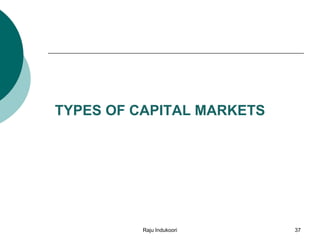Capital Markets
- 1. Capital Markets Dr Raju Indukoori
- 2. Topics • Introduction • Origin of capital markets • Need for capital markets • Functions of capital markets • Constituents of capital markets • Types of capital markets • Capital market and economic development. Raju Indukoori 2
- 3. Capital Market It is the market for long term capital requirements of corporations, government and government bodies comprising of debt and equity form of capital. It bridges the gap between net savers and net borrowers contributing to economic development and growth. Raju Indukoori 3
- 4. ORIGIN OF CAPITAL MARKETS 12th Century: Securities trading in Lyon, France. 1250s: Tradable bonds in Italy. 13th Century: Bruges, Belgium active trade center (Bourses)(Center) originated. 1350s: Venice, Pisa, Verona, Genoa and Florence, Italy - Active market for government securities. 1409: Antwerp, Netherlands became the heart of trading extended to Flanders, Ghent and Rotterdam. 1553: Muscovy Company (The Mystery and Companie of Merchant adventures fo the Discoverie of Regios, Dominions, Islands and Places Unknown) in London is the world’s First Chartered Joint Stock Company. 1585: Frankfurt Stock Exchange (Frankfurter Wertpapierbörse). 1602, Amsterdam Stock Exchange, Netherlands Launched by Dutch East India Company (VOC). 1611: The Dutch East India Company was the first corporation to be listed on a stock exchange (VOC). 1773 – London, UK. 1791 – Philadelphia, USA. 1792 – NYSE, USA. 1830s – Calcutta 1850s – Mumbai Town Hall. 1874 – Dalal Street ‘The Native Share and Stock Brokers Association (Bombay Stock Exchange. 1878 – Tokyo Stock Exchange, Japan. Raju Indukoori 4
- 5. Roof less Amsterdam Stock exchange in 1612 Raju Indukoori 5
- 6. Bond issued by Dutch East India Company on 07.11.1623 Raju Indukoori 6
- 7. Dalal Street in Early 19th Century. Raju Indukoori 7
- 8. NEED FOR LONG TERM CAPITAL A. Government Needs B. Companies Needs C. Individuals Needs D. Offshore Needs Raju Indukoori 8
- 9. A. Government Needs a. Fiscal Deficit. b. Public Expenditure. c. External payments. d. Infrastructure. e. Unforeseen Contingencies. Raju Indukoori 9
- 10. B. Companies Needs a. New business. b. Capacity Expansion. c. Export business. d. Working capital. e. Automation or Computerization. f. Meeting the legal standard or norms. Raju Indukoori 10
- 11. C. Individuals Needs a. Housing. b. Long Term Credit. c. Individual Business. d. Long Term Investments. Raju Indukoori 11
- 12. D. Off Shore Sector Needs a. Individuals – Investments – Repatriation b. Companies – Investments – Imports – Exports Raju Indukoori 12
- 13. Raju Indukoori FUNCTIONS OF CAPITAL MARKET A. Financial Intermediation B. Provide Income generation channels C. Participation promotion D. Market efficiency E. Contribute to Economic Growth F. Regulation 13
- 14. Raju Indukoori A. Financial Intermediation Long Term capital transfer from surplus savers to those with productive need. Provide channel for reallocation of savings to investments. Provides platform for demand and supply of capital through various financial securities. 14
- 15. Raju Indukoori B. Income Generations Channels Trading Investment Hedging Arbitrage Speculation 15
- 16. Raju Indukoori C. Participation Promotion Provides liquidity and tradability. The market provides a match for liquidity, maturity, risk and cost of capital of various securities. Risk management tools through hedging and financial derivatives. 16
- 17. Raju Indukoori D. Market Efficiency Lowers cost of financial transactions. Provide pricing mechanism promoting efficiency of capital allocation. Reflect valuation with efficiency of sensitivity of prices. 17
- 18. Raju Indukoori E. Economic Growth Capital market accelerate economic growth through the following. Promote Savings Culture Capital Formation Efficient Capital Allocation Build confidence among domestic and foreign investors by stabilizing the prices Accelerate Economic Development 18
- 19. Raju Indukoori F. Capital Market Regulation Disseminate information promoting transparency. Ensures safety and security through a regulatory system. Risk management through counter guarantee and risk. 19
- 20. CONSTITUENTS OF CAPITAL MARKETS Raju Indukoori 20
- 21. CONSTITUENTS OF CAPITAL MARKETS 1. Capital Market Instruments 2. Capital Market Participants 3. Capital Market Intermediaries 4. Capital Market Technology 5. Capital Market Regulators Raju Indukoori 21
- 22. 1. Instruments Equity Debt Hybrid Raju Indukoori 22
- 23. 2. Participants A. Issuers B. Lenders C. Investors Raju Indukoori 23
- 24. 2. Participants A. Issuers Companies : Debt and Equity Government: Central, State and Regional Government Bodies Raju Indukoori 24
- 25. 2. Participants B. Investors Retail investors Non Institutional : HNIs Institutional Investors Domestic Institutional Investors (DIIs) Banks Pension funds Mutual funds Foreign Portfolio Investors (FPIs) Raju Indukoori 25
- 26. 2. Participants C. Lenders Commercial Banks and Stock brokers do the lending activities in the following forms. Loan Securitization. Loans against securities. Margin Trade Funding. Employee Stock Option (ESOP) Scheme Funding. Broker Funding IPO Funding Application Supported by Blocked Amount (ASBA) Raju Indukoori 26
- 27. 3. Intermediaries Stock Exchanges National Stock Exchanges : NSE and BSE Regional Stock Exchanges: NDSE, CSE, MSE……. Stock Brokers Stock exchange members Sub Brokers and Franchisee Commercial Banks: Application, Payment, receipts Merchant Banks Underwriters Registrars Individuals : Commission Agents, Brokers, Fee based consultants. Raju Indukoori 27
- 28. 4. Technology Screen based trading Online trading Dematerialization Clearing and Settlement. Raju Indukoori 28
- 29. NSE Technology National Exchange for Automated Trading (NEAT). Open Dealer Integrated Network (ODIN). Computer to Computer Link (CTCL). NEAT on Web (NOW). Algorithmic Trading for Institutional Traders through co location. EMERGE for Small and Medium Enterprise (SME) stocks. Mutual Fund Service System (MFSS) for web based mutual fund trading. NSE Mutual Fund (NMF) Platform for distributors. Raju Indukoori 29
- 30. 5. Regulators Raju Indukoori A. Ministry of Finance (MoF). B. Reserve Bank of India (RBI). C. Securities Exchange Board of India (SEBI). D. Securities Appellate Tribunal (SAT). E. Self Regulatory Organizations(SROs). 30
- 31. A. Ministry of Finance (MoF) Raju Indukoori Headed by Union Minister of Finance and Minister of State. It has 5 departments as follows. a. Department of Economic Affairs. b. Department of Financial Services. c. Department of Investment and Public Asset Management. d. Department of Expenditure. e. Department of Revenue. 31
- 32. A. Ministry of Finance (MoF) Raju Indukoori Department of Economic Affairs (DEA) DEA directly manages capital markets by formulating rules and regulations in the direction of MoF. Headed by the Secretary, Economic Affairs Chief Economic Advisor Assistant Secretary, Economic Affairs Assistant Secretary, Investments Financial Markets division of DEA controls or regulates capital markets under direction of MoF. 32
- 33. A. Ministry of Finance (MoF) Raju Indukoori Financial Markets Division Securities Contracts (Regulation) Act 1956. Forward Contracts (Regulation) Act 1952. Securities and Exchange Board of India Act, 1992. 33
- 34. C. Securities & Exchange Board of India(SEBI) Raju Indukoori • SEBI is the apex body governing the Indian stock exchanges. • The Securities & Exchange Board of India (SEBI) Act, 1992 regulates the functioning of SEBI. • The participation in the Indian Stock Market of both the domestic or foreign financial intermediaries are governed by the regulations framed by SEBI. • Foreign Portfolio Investors (FPIs) can participate in Indian Stock Market after registering them with an authorized Depository Participant. 34
- 35. SEBI Functions Raju Indukoori Protective Functions I. It checks Price rigging II. Prohibits insider trading III. prohibits fraudulent and Unfair Trade Practices Development Functions I. SEBI promotes training of intermediaries of the securities market. II. SEBI tries to promote activities of stock exchange by adopting a flexible and adaptable approach Regulatory Functions I. SEBI has framed rules and regulations and a code of conduct to regulate the intermediaries such as merchant bankers, brokers, underwriters, etc. II. These intermediaries have been brought under the regulatory purview and private placement has been made more restrictive. III. SEBI registers and regulates the working of stock brokers, sub-brokers, share-transfer agents, trustees, merchant bankers and all those who are associated with stock exchange in any manner IV. SEBI registers and regulates the V. working of mutual funds etc. VI. SEBI regulates takeover of the companies VII. SEBI conducts inquiries and audit of stock exchanges. 35
- 36. E. Self Regulatory Organizations (SROs) Raju Indukoori Stock Exchanges: NSE and BSE. Depositories: NSDL and CDSL. Association of Mutual Funds in India (AMFI). 36
- 37. TYPES OF CAPITAL MARKETS Raju Indukoori 37
- 38. Types of Capital Markets 1. Primary market (Fresh First Issue Markets) 2. Secondary market (Stock Exchanges) 3. Third market (Tertiary Markets) 4. Fourth market (Direct Markets) Raju Indukoori
- 39. 1. Primary Markets This is the market for issue of new or fresh securities by a company or government or government body for the first time or again and again. This market can be classified as follows 1. Primary Debt Market 2. Primary Equity Market Raju Indukoori
- 40. 2. Secondary markets This is the market for trading of existing or listed securities of different issuers. These are the markets for debt, equity and derivative products. They can be classified as follows. 1. National Stock Exchanges: NSE, BSE, MCXSX 2. Regional Stock Exchanges: NDSE, CSE, MSE, HSE, BgSE, Raju Indukoori
- 41. 3. Third markets It is the market for trading between the parties without exchange as the platform. The product in terms of quantity, order, pricing are customized when compared to an exchange. It has no or low liquidity Unlike exchange trading, OTC trades have low liquidity and high risk as they doesn’t have counter party risk guarantee. In India OTCEI is the form of this market and in USA it is carried out by Market Makers. Debt, equity and derivatives products are traded in OTC Markets. Raju Indukoori
- 42. 4.Fourth market It is the institution-to-institution direct trading bypassing the services of a stock exchange and brokers. They are also known as direct markets. a. avoiding both commissions b. Absence of spreads. c. Block trades d. Trades are not subject to reporting requirements. e. Confidentiality of trades. Raju Indukoori
- 43. Direct Market Access (DMA) DMA is the alternative of fourth market. It is the electronic trading facilities that gives the traders or investors to interact with the order book of the exchange which is usually restricted to the exchange members. Buy side firms, sell side firms and private traders are the major participants. It is meant for algorithmic trading strategies with privacy. Raju Indukoori
- 44. Economic Development and Growth with Capital Markets Capital formation. Capital markets fulfill long term capital needs. The role of capital markets is important for a country’s economic development. The growing size of capital market indicates more wealth accumulation in the economy. Three sector’s participation is more important in terms of source as well as need. Raju Indukoori 44














































